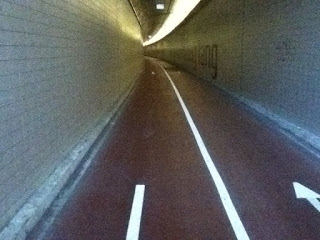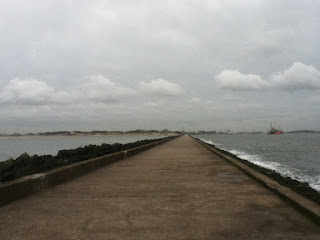Sunday 23 August
Zeddam is a small town, having the honour of having the oldest restored, still working flower windmill and the oldest "Rosmolen" in the Netherlands dating from the early fifteenth century. A rosmolen is a mill driven by a horse walking in a circle pulling a wooden gear arrangement.
Leaving Zeddam I ride amongst the different arms of the rivers Maas and Rijn, which combine with several other smaller contributories, forming the delta where the dutch settled, or were driven to, and crafted the Hollow Land we know as Holland or the Netherlands today. This mass of waterways wind their way through the countryside to reach the North Sea, and my final destination.
I pass through Beek, Babberich and Loo, where I connect with the water again and keeping the water on my left, to Westervoort. There instead of crossing the IJssel, another contributory, I ride for several km to the North up the IJssel, before I realise my mistake. Funny after more than 3000 km, I loose my way here! I backtrack and continue, finding my way through Arnhem and Oosterbeek, turning inland through the forests of the Veluwe to Wolfheze, Ede and Renswoude to Scherpenzeel and my oldest friends Frans and Ellen. Oldest in the sense that we have been friends for the longest time.
Riding 80 km, climbing 190 m, temperature 31C, average speed 21,9 km/h.
Tuesday 25 August
Away early and through Maarsbergen over the Utrechtse Heuvelrug, the dutch mountain range peaking at around 75 m. Yes no misprint 75m with snow in winter!
A fast descent into Doorn, through the forest and onto Langenbroek
The landscape changes to flat big sky country, with the rivers contained by dykes, protecting the farms and cities witch are often below sea level. The low laying areas called "polders" are kept dry by many pumping stations, replacing the many windmill driven pumps from the past, proudly preserved,
Dutch icons and tourist attractions.
Dutch icons and tourist attractions.
I continue through Cothen, Schalkwijk and Schoonhoven where I stop and have a some raw herring for lunch, following the river Lek again through Ammerstol to Krimpen aan de Lek.
I take the ferry to Slikkerveer, through Barendrecht and around the Southern rim of Rotterdam to Poortugaal to visit my brother Arie and family.
Riding 115 km, climbing 202m, temperature 27C, average speed 18.4 km/h.
Wednesday 26 August
Today I embark on a side trip to the small city of Delft, famous for its blue pottery industry. It is an old city, but vibrant with a large student population, of one of Hollands top universities the T.H. Delft, specialising in engineering.
I meet up with fellow kiwis Allan and Margaretha Cooper, who are on an European holiday too and we enjoy a lovely lunch in the city square, great catching up and easy to do on the excellent public transport system in Holland.
Thursday 27 August
I will run out of land today, when I ride to the end of the pier in Hoek van Holland and the end of this adventure. Leaving Poortugaal, I ride through the massive harbour district of Rotterdam, extending from the city, through Pernis with its refineries, container terminals and industries on both sides of the water.
The two main rivers that come together here are prone to silting up from natural erosion, from stones, now mainly sand carried down from the alps and the sources of the rivers. Constant dredging was necessary to maintain access to the growing city of Rotterdam. A civil engineer Nicolaus Cruquius drew up plans to divert the rivers and create a waterway straight to the sea from Rotterdam in 1731. It took some law changes, land acquisitions and some more innovating design by Peter Calland in 1872 before this proposal was realised in 1877 and the "Nieuwe Waterweg" was built. Peter Calland's design included the ratio of water diverted to the amount allowed to flow through this newly built waterway, that no dredging was needed and unimpeded access would be achieved. This has been true until the introduction of the super tankers and since then occasional dredging is carried out. To put the size of the harbour into perspective, it is the largest port in Europe and one of the largest in the world, 180,000 people work in the harbour, annually 30,000 sea going ships birth and 110,000 inland ships for cargo transfer into Europe birth here. Taking just the sea going ships, having to leave the harbour as well, that gives us 60,000 ships passing through Hoek van Holland. That is 164 each day or almost 7 each hour.
The Netherlands has an amazing infrastructure with a separate cycling network. And cycling through this harbour is no different. After Pernis the cycleway needs to cross the railway corridor and the motorways on several occasions.
A steep ramp leads up to an overpass, for the elderly or less fit there is the option of using an escalator to get up to the overpass level. Quite amazing. In order to get to Hoek van Holland one has to cross the water.
The Benelux tunnel has a section just for bicycles and again a long steep escalator takes one down to the tunnel and a well lit 2 lane bikeway provides an almost level ride to the other side. For people with loaded bikes or who don't like escalators there is also a lift to get one back to above ground.
The tunnel connects to Vlaardingen on the North side of the river and after passing through Maassluis, a cycleway along the waters edge runs all the way through to Hoek van Holland and the pier.
Looking back landwards to Hoek van Holland.
Looking back landwards to Hoek van Holland.
The final ride was 35 km, climbing 67 m, temperature 27C, average speed 18.4 km/h.
The total tour was 3,603 km, climbing 22,604 m, 5 days with a shower, 1 thunderstorm. No punctures. Visiting 7 countries. No accidents or mishaps.
A great ride, met many very nice people, I am extremely fortunate. Thank you all, who followed for your interest, comments and support.




















1 comment:
Oh is this the end ? �� I suppose we can cope with you back here again! ��
Janey xx
Post a Comment